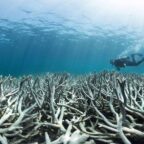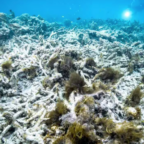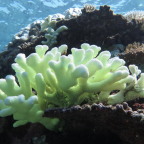
Dozens of small coral fragments are anchored to a man-made underwater frame, suspended just a few metres below the surface on the Great Barrier Reef. The pieces of staghorn coral are only a few centimetres long at best, but represent something much greater than what I can see. My divemaster Russel Hosp holds up a sign underwater to communicate.
“We call these fragments of opportunity,” it reads.
I’m diving at a coral nursery with Passions of Paradise, an eco-certified operator which departs from Cairns daily to take guests out to dive and snorkel the famous reef and one of 13 operators certified as carbon-neutral. Among its many initiatives, Passions partners with a rainforest conservation programme which works in Queensland’s ancient Daintree Rainforest, which helps buy back ex-agricultural land and replant it with native trees.
But it’s the work that Passions is undertaking underwater that is the most visible for dive tourists to see. In the last three years, the team at Passions has planted over 7000 pieces of coral at three sites at the Hastings Reef. A significant portion of that replanting was undertaken during the Covid lockdowns, as the programme was considered an essential service.
Most coral replanting programmes have a success rate of about 50-60%, however Passions is averaging at 80%.

“Hastings Reef is our rejuvenation site. It’s been in the crosshairs with Cyclone Yasi in 2011, then the crown of thorns outbreak in 2012, and subsequent bleaching events,” says Hosp. But despite the bad press, Hosp wants to remind people that the Great Barrier Reef is still alive.
“It hasn’t been destroyed or dead like people say. We fight this all the time.”
Cyclones, coral bleaching, starfish outbreaks – is it any wonder people are confused about the health of this World Heritage area. A collection of nearly 3000 individual reefs spanning 2300 kilometres off the coast of Queensland, the Great Barrier Reef is one of the world’s most treasured spaces, but needs ongoing work and protection to minimise the harm caused by climate change and overfishing. Now, dive tourists can be part of the efforts to enhance resilience of the reef.
Bleaching is one of the more misunderstood impacts on the reef. It occurs when the ocean’s temperature rises, resulting in algae which live inside coral to produce a toxin, which forces the coral to expel the algae out. It’s the absence of this algae that turns the coral white, giving it its bleached appearance.
Contrary to what some people think, bleached coral is not dead and it can survive for around 8 to 12 weeks until the water temperature drops. Not all coral bleaching events affect the entire Great Barrier Reef either. However, it’s the increasing frequency these mass bleaching events are occurring that pose such a big threat, as there’s not enough downtime for corals to recover.

Drifting along underwater, Hosp leads me to several more underwater frames, all showing the coral fragments at different stages of their growth journey, from three, six to 12 months, resulting in those once tiny pieces of coral now blooming and intertwining with one another, bursting with pops of colour from the tiny fish swimming around.
From there, pieces of coral are broken off and replanted onto the reef, attached with a steel clip that corrodes and biodegrades over time. Coral can reproduce sexually and asexually, the latter includes fragmentation, where pieces break off, cement itself somewhere and build a brand-new piece in that site.
For the rest of the dive, I follow Hosp around the reef watching him replant coral, check on existing pieces that have already been propagated, collect invasive snails that can damage the reef, all the while marvelling at the incredible exhibits of coral on display. It’s a remarkable opportunity to see coral rejuvenation in action.
During our surface interval, lunch is served onboard and guests unwind, dry off in the sun, mingle with others or have a nap. Sunblocked bodies lie on the nets at the front of the catamaran, every spot that might have even an inch of sun is taken is nabbed. It’s one of the relaxing and social parts of any boat trip – where divers and snorkellers return to the boat high on seeing the life underwater, first-time and experienced divers wide-eyed with delight, tummies ready for a feed and excited minds are eager to share their sightings with others.

Hosp is a Master Reef Guide, an initiative that highlights the very best expert storytellers and reef guides. Guides have to be nominated and then accredited by the Great Barrier Reef Marine Park Authority, Association of Marine Park Tourism Operators and Tourism and Events Queensland. Throughout the day, he talks me through the coral nurturing programme and the ‘citizen science’ opportunities for travellers.
Dive tourism can be a double-edged sword if not controlled, but with operators like Passions of Paradise, it can help not only educate travellers about the marine environment, but give them a chance to participate in valuable research.
Divers can be a marine biologist for a day and collect real time data for reef monitoring initiatives such as Queensland’s ‘Eye on the Reef’ programme. By recording animal sightings, incidents or reporting on reef health, divers feed that information back into a bigger database to help with the ongoing protection and preservation of the reef.
“The reef is really resilient, it will come back,” Hosp explains.
During our second dive, we visit another site that looks like a blooming underwater garden with layers upon layers of hard and soft coral, coral that resembles everything from lavender bushes and bonsai trees, to giant plates protruding out as if there purely to serve up a display of fish to passersby. There are striking blue sea anemones nestled on boulders, screeds of angelfish and damselfish in vibrant multi-hued displays, and of course the iconic orange flash of inquisitive anemonefish, perhaps the most recognisable fish of the Great Barrier Reef thanks to the movie Finding Nemo.

We’re in less than 10m of water so most of the fish I see are small and colourful rather than the big pelagic species, but the site is bursting with energy and colour. Coral reefs cover less than 1% of the ocean, but are home to nearly a quarter of all marine life. As well as playing a crucially important role in the marine ecosystem, coral reefs support and generate millions of tourism jobs worldwide and play a major part in many economies.
The journey back to Cairns takes about two and a half hours, and Hosp uses the voyage to give an educational talk to explain the health of the reef and educate guests on the impacts of climate change and overfishing.
I think about what I’ve witnessed underwater and can tell you straight up that the reef is anything but dead, and still offers one of the more colourful, impressive dives you’ll experience, but with the added bonus of coming away with a better education and newfound advocacy for this special part of the world.
The Great Barrier Reef is an international treasure – so make sure your trip there counts.















Social Profiles